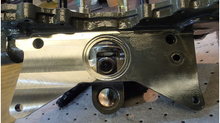Servo Mount Nuts
Hi this is Pete from Metro Fire again. On the NTSB accident website there is an accident involving aircraft UH-1H N260TA 5-23-2014. There is little information as to the cause.
The pilot stated to the deputy sheriff on-scene that immediately after takeoff the helicopter started hopping. He attempted to land the helicopter but had no control.
I can not say what happened in this incident but have seen the following on three aircraft in the military two others in the civil aviation and heard of another.
Any of the Three servos, both cyclic & collective where mounted to the airframe have had one or all of the mounting nuts backing off ( losing torque ). I personally have seen all of them loose on three aircraft and one to the point that one nut was missing with the servo moving a ¼ inch or more.
Once this starts the nut looseness will accelerate rapidly. Depending on how loose they are this allows the servo assembly to move up and down un-commanded. Every time it moves it will unseat the pilot valve causing the servo to react. The servo mount nuts should be inspected regularly.
Remove the two forward side panels and you can see all three servos. If there is oil in this area you may see black residue around the nuts and washers, a sign they are nut tight. Check the torque before next flight. The problem can occur even if you use new nuts at each installation.
The nuts are not the only thing that wears with removal and installation so does the stud. The more hours the aircraft has the greater chance the studs are worn from repeated servo changes.
In the cases where I was involved we changed all of the studs and started over. I am including a photo of the servo mount I am talking about.
Peter Frinchaboy
Helicopter Maintenance manager
Sacramento Metro Fire District




































